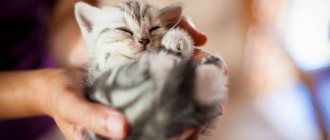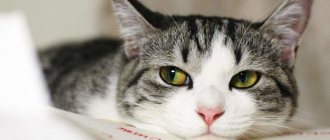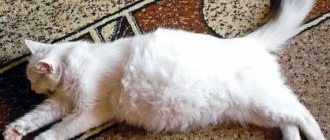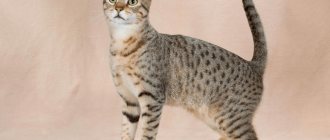For some reason, Persian cats and the breeds that are included in this group (Himalayan, exotic) are considered long-lived. They often live to the ripe old age of 20, but there is no official data on this. The lifespan of animals is influenced by many factors, from hereditary predisposition to living conditions.
Recommendations from competent breeders will help you figure out how to prolong the active life of a Persian cat at home.
How long do cats live on average?
Domesticated cats (without regard to their gender) stay in this world for about 12–15 years . But precedents for cats crossing the 18-20 year mark are not so rare.
Some sources also contain more fantastic figures (36–38 years), allegedly supported by the testimonies of those who were lucky enough to raise long-lived cats. This information can hardly be considered 100% true due to the lack of official confirmation.
Domestic cats that have lived next to their owners for 20 years or more are not considered curiosities. As a rule, their long life is ensured by strong heredity and owners who were able to optimally organize the cat’s life, nutrition and leisure.
Some people are still convinced that stray cats are more adapted to harsh reality than their domesticated counterparts, and, therefore, differ from the latter in having a longer life span.
In reality, everything looks exactly the opposite: street cats rarely live even up to 10 years, and on average they live 6–9 years. The explanation is simple: yard animals are surrounded by external dangers (threatening infections, lack of food, bad weather, flayers, dogs and cars) and are in constant stress.
Return to content
History of the origin of exotics
global $ads_google;
//data-ad-slot=”2475549904″ $ads_google = empty($ads_google) ? false : true; ?> if ($ads_google == false) {?> $ads_google = true; ?> } ?> The exotic cat today is included in the lists of popular and favorite breeds. And these amazingly cute cats turned out as a result of failure in the process of experimental selection. According to the letter of history, breeders decided to cross a Persian with an American Shorthair to get a greater variety of colors. But the result was not a Persian, not an American, but wonderful plush, almost toy-like, exotic kittens.
From the Persians they inherited the pretty expression of a childish, doll-like snub-nosed muzzle. They got their plush fur from their short-haired ancestors.
Strange, but the origin of these cuties was not very well received by supporters of purebred crossing, seeing this as an attempt to change the phenotype of the Persians. Fortunately, there were also admirers of the new breed, and soon work began on breeding a population of plush short-haired exotics. Not only the above-mentioned cats took part in it, but also Burmese and Russian Blue. Today they are recognized by the World Cat Fanciers Association.
How many years do Persian cats live?
Ordinary Persians fall within the average cat life span, living up to 15–20 years . But, since there is a clear division into subspecies within the breed, each of them is predisposed to longevity in different ways.
This is explained by the selective invasion of the breed, which directly affected the health and lifespan of the Persian cat. True, felinologists have still not come to a common opinion regarding the number of intrabreed varieties.
Important! The most orthodox classification assumes the presence of two types (modern and classic), some breeders also speak of a third (extreme) type of Persian, and, finally, a considerable proportion of experts identify a fourth type, piggy.
The last two types, extreme and piggy (as a clear manifestation of the extreme), are considered the most vulnerable in terms of immunity and health. Persian cats of these two varieties suffer due to the fault of geneticists, who have adjusted their faces to the point of almost complete inability to breathe (especially in the heat).
Extreme Persians (even with a loving owner and competent maintenance) usually do not overcome the bar at 15 years, while classic/European Persians live up to 20. It is generally accepted that among the Persians there are no long-livers who surprised their owners with a life span of more than 20 years , but on one of the forums there was an entry about a Persian cat who recently turned 24 years old.
Return to content
Conclusions about the breed
The Persian cat is a worthy pet that will quickly become the beloved youngest child in the family. She will always be close to the owner, without imposing her attention. With the proper level of care, a cat of such a noble breed will live a long life, decorating the owner’s home with its existence. Despite the fact that his fur coat will require daily attention and care will take a lot of time, such a pet will bring a lot of joy to its owners with its affectionate character and devoted attitude towards the family.
What affects life expectancy
A combination of factors, ranging from heredity to psychological comfort, is responsible for the lifespan of domestic cats.
Breed
All animals of indigenous breeds that have retained their natural qualities live much longer than cats, the breeding of which has been actively developed by breeders. Endless improvement of the exterior rarely comes without side effects that affect the health of the experimental subjects.
On the other hand, a stray cat will never outlive a purebred cat born from proven sires without genetic abnormalities . Yard cats choose their own partners and copulate without thinking about their offspring, which is fraught with all the delights of inbreeding and chaotic mixing of chromosomes.
Heredity
This nuance is no less important than purebred. For example, all breeders know that native South Asian cats (Siamese, Burmese and Burmese) have an enviable life expectancy. If your Persian’s ancestors include record holders and long-livers, most likely he will try to strengthen the glory of his family and end his life in old age.
Spaying
Castration or sterilization of a Persian cat is indicated for several reasons:
- normalization of hormonal levels;
- absence of sexually transmitted infections;
- exclusion of childbirth as a factor shortening the cat's life.
Animals not engaged in breeding activities are taken to a surgeon, as a rule, after they are one year old.
Lifestyle
It consists of regular physical activity, favorable living conditions, proper food and, of course, frequent hygiene procedures. To force your dog to jump and run, buy a gaming set, and also try to walk in the fresh air as much as possible.
Diet
Organizing the nutrition of a Persian cat is also a kind of science (due to the gastronomic selectivity of the breed).
Important! If you feed your pet unsuitable food or low-quality products, expect ailments on a variety of fronts: stomach, liver, bladder, heart, blood vessels, musculoskeletal system and intestines.
Body mass
The connection is simple - the fatter the Persian, the less chance he has of becoming a long-liver. Your pet's diet and lifestyle are responsible for weight.
Diseases
Throughout its life, every cat suffers from something, and the more serious the illness, the more fatal its health consequences. Infections, parasites, injuries, congenital defects - all this shortens a cat's lifespan.
Vaccination, deworming and routine examinations at the veterinary clinic will help prevent the most dangerous diseases.
Stress
A cat that is in constant fear or anxiety will not live long: most somatic diseases occur against a background of chronic stress. But surrounded by love and care, a cat will try not to leave you for as long as possible.
Return to content
Relationships with other animals, children
Persian cats have an obedient, quiet, calm disposition. Adults are not hyperactive and love to spend their time basking in the warm rays of the sun. Animals of this breed are open towards others and do not like to enter into conflicts. With rare exceptions, they engage in skirmishes for leadership, often with other cats rather than with larger or smaller opponents. Persians are indifferent to birds and rodents.
Persian cats communicate willingly with children, allowing them to touch them, pull their tail and whiskers. They will never attack small, defenseless babies. In critical, stressful situations, Persians are tactful and not impulsive. They would prefer to sit in the shadows rather than engage in open confrontation.
Cats of this breed can commit mischief only by accident, having forgotten themselves in the game. They will not consciously take revenge and remember something that went wrong.
How to extend the life of a Persian cat
Over the past hundred years, the breed has been so “shredded” by breeders that the body of Persian cats (especially extreme cats) has noticeably weakened . Some animals already have one or more hereditary ailments from birth, such as:
- polycystic kidney disease;
- hypertrophic cardiomyopathy;
- retinal atrophy (progressive) and blindness;
- increased lacrimation;
- liver and bladder diseases;
- diseases of teeth and gums.
Of course, conscientious breeders exclude Persians with defective genes from breeding work, which cannot be said about scammers who mindlessly breed cats in pursuit of profits. In addition, not all congenital diseases appear at an early age: for example, polycystic kidney disease in Persian cats is observed closer to old age, at 7–10 years.
This is interesting! Ask the breeder (before purchasing) to give you a medical certificate certifying that both the kitten and its parents have no health problems. If we are talking about polycystic kidney disease, this may be a conclusion after an ultrasound from both manufacturers.
Already at 4-8 weeks of age, a small Persian may develop progressive retinal atrophy. If you miss the onset of the disease, after one and a half to two months the kitten will be completely blind.
Monitor the condition of your pet's nostrils, especially if he is of the extreme type. Due to the structure of their faces, it is very difficult for such cats to breathe fully, so clear their nasal passages of secretions and dust.
Difficulties with breathing are aggravated in stuffy, humid rooms and in hot weather. Turn on air conditioners and fans, and also give your cat Corvalol (2-5 drops) if she becomes ill.
Like many brachycephalic breeds, Persian cats suffer from excessive tearing, leading to unsightly tear tracks, inflamed skin and deteriorating coat appearance. In this case, drops with herbal ingredients will help, as well as a special powder that masks traces of tears.
Pay attention to the cornea of the Persian's eyes, which can be injured by his own long hair. Also, do not forget about regular procedures (combing the coat, cleaning the ears, trimming the claws and oral hygiene).
Important! Persian cats do not suffer from a tendency to obesity, but they are often couch potatoes, which is why it is necessary to control the amount of food they eat and teach them to exercise.
If your dog goes outside or goes to the country, put anti-parasitic collars on him and apply flea/tick medications to his withers . Since Persian cats cannot boast of excellent health, visit the veterinarian more often (at least once every six months).
Return to content
Character
The Persian cat is one of the most suitable for living in a family.
This breed is unlikely to survive in the wild. She is sociable: she gets along well with children, even the capricious and annoying ones. Falls in love with the owner once and for all: protects, heals and “worries” about the person. Persians are incredibly in need of love and affection, so they happily endure trips and relocations next to their beloved owner. While its owner is away, the Persian cat “freezes”: it may not touch food or drink, or even leave one place. But when someone from the family crosses the threshold, the pet literally comes to life! This breed takes care of its offspring like no other. Moreover, the Persian cat considers the owner to be “involved” in pregnancy and childbirth: while bearing offspring, she constantly shares her experiences with you, and after giving birth, she is sure that you must care for the cubs together - feed, play and lull the babies “in four hands.” However, the cat is simply torn between the need to be with her beloved owner and maternal duty
Conclusion: a pregnant and lactating Persian cat needs to be surrounded with even more attention and love. Temperament varies among Persians, but they are not aggressive. Persian kittens are always funny and restless, and they remain that way for many years if a person supports the cat’s playful behavior
In any case, this breed will never “talk back” to a person, calmly withstanding all the squeezing and hooting directed at it.
For “connecting” to the owner’s problems, the Persian cat often pays with a weak immune system.
Persians are a rather naive and curious breed. Therefore, they need special living conditions, such as:
- remove all medications and chemicals;
- When cooking, make sure that your pet does not jump onto the stove or hot dishes;
- check the washing machine and dryer - the cat can easily fall asleep there;
- Provide the windows with high-quality nets – this breed loves to sit on the windowsill.
Wool
Caring for the hair of a Persian cat is an entire art that requires special means and consistent actions.
Combing your pet takes place in several stages: we go over it with a thin comb, then carefully comb it with a medium comb and smooth it with a fine brush. Frequency – once every 2-3 days.
Conditioner or spray can be used during or at the end of the procedure, they will give your Persian's coat a healthy look and shine. Don't forget about cat antistatic agents.
It's time to find out what a Siberian cat is like - the character and other interesting features of the breed - under the picture.
And this article will teach you how to recognize and treat worms in domestic cats.
All about tablets for deworming in cats https://kotovasia.net/...79.html
Bathe your animal once every 2-3 weeks with a quality shampoo for long-haired cats.
After water treatments, pat the coat dry with a towel and gently comb it until completely dry, naturally, in a warm room.
Persian cats should be trimmed without touching the tail. But remember that you cannot cut colorpoint Persians to avoid pigmentation.
Nutrition
What to feed a Persian cat is one of the most important issues in keeping the breed. Ideally, you need to equally combine good food with homemade food:
- almost half of the diet is proteins (lean meat, fish, dairy, soybeans);
- carbohydrates (cereals, bread, root vegetables, oatmeal);
- necessary vitamins (olives, asparagus, boiled or raw vegetables, fruits).
The main thing is to keep seasonings and spices out of your cat’s diet.
A Persian can catch mice if this instinct is awakened in the kitten from 3 to 6 months.
Diseases
The Persian is a cat breed with fairly good health, but they have several hereditary diseases, for example:
- polycystic kidney disease;
- blindness (manifests by 4-8 weeks, after a couple of months the animal becomes completely blind);
- excessive tearfulness of the eyes due to a flat muzzle (need eye care - blotting with a napkin, treating with a special lotion);
- hypertrophic cardiomyopathy;
- Persian cats are also susceptible to gingivitis, the formation of tartar and plaque.
Your pet should be checked by a veterinarian every few months.
Persian diet
The better a Persian cat eats, the better it looks. Feed her with professional food from James, First Choice, Eagle Pack, Royal Canin, Askana, and Hills brands. Dry food is low in liquid, so add broth to it. With proper feeding, the purebred miracle will be healthy, happy and in gratitude will give you affection and love. Add the following foods to your daily diet:
- Boiled lean meat without bones.
- Boiled or steamed sea fish without bones.
- Vegetables are raw, steamed or boiled.
- Low-fat fermented milk products. Milk can be given to kittens up to four months of age; in adult cats it can cause stomach upset. Give calcium-rich curd products. Hard cheese no more than once every 3 days.
- Greenery.
- Fresh water.
- Taurine, minerals, vitamins - as recommended by a veterinarian.











